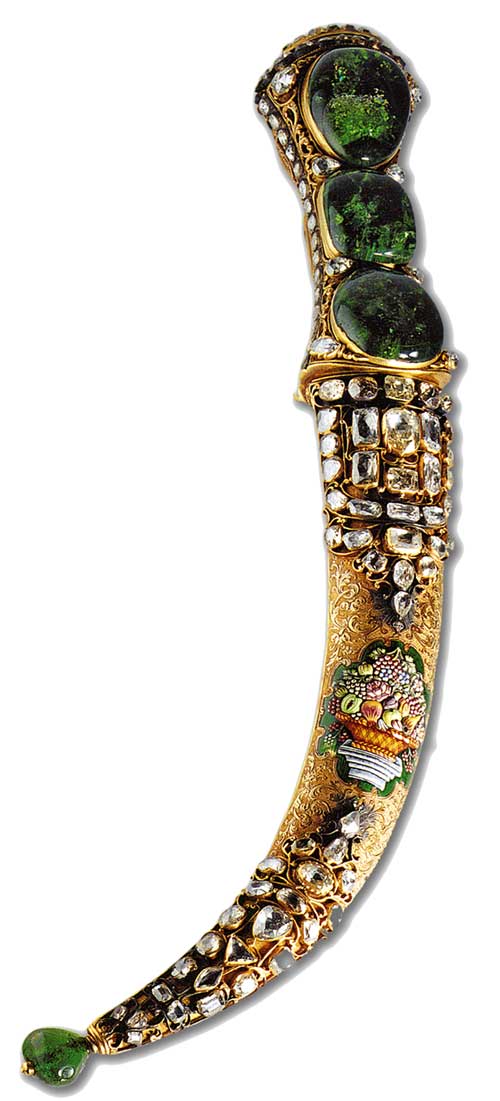The Topkapı Dagger, named for the famous palace and museum in which it sits, represents another kind of diplomacy. Fashioned in the early 18th century by Ottoman craftsmen, the emerald-studded weapon was meant as a peace offering to the Persian successor of the Safavids, Nadir Shah. A military force of nature whose ambitions prefigured Napoleon’s, Nadir Shah had defeated the Mughal ruler and sacked Delhi in 1739, making off with the lion’s share of Muhammad Shah’s accumulated treasures, including thousands of Colombian emeralds. Many were later incorporated into a jewelled globe to prevent theft. The Topkapı Dagger was commissioned for Nadir Shah in 1746, but it appears he was already cursed by Mughal treasure. Obsessed with protecting his hoard and increasingly distrustful of his many subordinates, Nadir Shah lashed out at those whom he might have co-opted. He was assassinated in 1747, just in time for the Ottoman ambassadors carrying the emerald-handled dagger to find out before crossing the Persian frontier, allowing them to return to Istanbul. The Topkapı Dagger, which is also inset with an English watch at the top of the hilt, stands as a mute testament to early modern globalisation.
TOPKAPI DAGGER
Kris Lane
Further reading
- Bycroft, M., and S. Dupré (eds.) (2019) Gems in the Early Modern World: Materials, Knowledge & Global Trade, 1450–1800 (London: Palgrave).
- Domínguez, R. (1965) Historia de las esmeraldas de Colombia (Bogotá: Gráficos Ducal).
- Forsythe, H. (2003) The Cheapside Hoard (London: Museum of London).
- Giuliani, G., M. Chaussidon, H.-J. Schubnel, D.H. Piat, C. Rollion-Bard, C. France-Lanord, D. Giard, D. de Narvaez, and B. Rondeau (2000) ‘Oxygen isotopes and emerald trade routes since antiquity’, Science, vol. 287, 631–3.
- Jaffer, A. (2017) Treasures of the Mughals and the Maharajas: The al-Thani Collection (Milan: Skira).
- Keene, M. (2001) Treasury of the World: Jewelled Arts of India in the Age of the Mughals (London: Thames & Hudson).
- Lane, K. (2010) Colour of Paradise: The Emerald in the Age of Gunpowder Empires (New Haven/ London: Yale University Press).
- Meen, V.B., and A. D. Tushingham (1968) Crown Jewels of Iran (Toronto: University of Toronto Press).
- Otero Muñoz, G., and A.M. Barriga Villalba (1948) Esmeraldas de Colombia (Bogotá: Banco de la República).
- Peretti, A., and T. Falise (2017) Magnificent Green: On the Trail of the Legendary Colombian Emerald (Hong Kong: Gem Research Swisslab).
- Schmetzer, K., G. Martayan, J. Guillermo Ortiz, and A.R. Blake (2018) ‘Rediscovery and history of the Chivor emerald mines: between legends and reality (1880–1970)’, InColor Special: Emerald, vol. 40, 58–63.
- Sinkankis, J. (1981) Emerald and Other Beryls (Radnor, PA: Chilton Book Co.).





